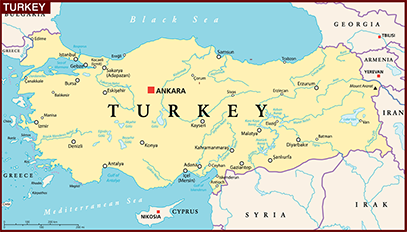Pharmacoeconomic Guidelines: Turkey
Country/Region: Turkey

Submission Guidelines
| Social Security Institution - The Procedures and Principles for Medicine Reimbursement Applications |
Submission Guidelines Source:
Information current as of Monday, February 5, 2024
Key Features
| Key Features | |
|---|---|
| Type of Guidelines | Submission Guidelines |
| Title and year of the document | Social Security Institution - The Procedures and Principles for Medicine Reimbursement Applications (2024) |
| Affiliation of authors | Social Security Institution |
| Purpose of the document | To determine the procedures and principles to be followed in applications made for medicines for which financing is requested to be provided by the Social Security Institution. Pharmacoeconomic evaluations are also included within these procedures and principles. |
| Standard reporting format included | Yes |
| Disclosure | Yes |
| Target audience of funding/ author's interests | Pharmaceutical companies |
| Perspective | The provider and the payer |
| Indication | Approved indication: First and additional indication(s). Recommended dosage and duration of treatment for this indication(s). |
| Target population | Projected prevalence rates of approved indications, classified by ICD-10 codes, within Turkey, alongside an estimation of the patient population affected. |
| Subgroup analysis | Not specified. |
| Choice of comparator | 1- The current medication(s) to be replaced by the newly compared medicine upon its market introduction are selected. The reasons behind this selection and the criteria for choosing are elucidated. 2- If the medication belongs to an existing pharmacotherapeutic group, it is compared with the most commonly used alternative within that group and with alternative medication(s) directly compared in the literature. 3- In the case of the medication being the first member of a new pharmacotherapeutic group, it is compared with the most commonly used medication(s) for the same indication(s) from other pharmacotherapeutic groups, as well as with medications directly compared in the literature. 4- If there are non-pharmacological treatment options available for the same indication (such as surgical intervention, radiotherapy, physical therapy, etc.), these options are compared accordingly. 5- If the most common practice is observation without treatment for the same indication, the comparison is made based on this scenario. |
| Time horizon | A three-year duration for cost calculation. |
| Assumptions required | Must be clearly described and justified. |
| Preferred analytical technique | Pharmacoeconomic analysis is performed by either cost minimisation or cost-effectiveness methods and includes an appropriate sensitivity analysis. In addition to cost-effectiveness analysis, analyses conducted through the cost-utility method can also be presented. |
| Costs to be included | Direct health expenditures. |
| Source of costs | The marketing authorization holder must provide specifications. Data from Turkey or other countries are acceptable. If pharmacoeconomic analysis has been conducted using data from other countries, specific adaptations for Turkey—such as details regarding hospital services, medicine costs, consultation fees, application expenses, etc.—must be outlined. In the absence of Turkey-specific data, estimated information may be utilized, provided that reasons and sources are disclosed. |
| Modeling | Although specific information about modeling is not provided, a three-year projection is requested for the patient population, cost, and budget impact. |
| Systematic review of evidences | The clinical trial(s) utilized for pharmacoeconomic assessment rely on data derived from clinical trials published as original articles, specifically in journals encompassed within SCI/SCI-Expanded (excluding letters to the editor, abstracts, reviews, short communications, and book reviews), or those planned for marketing authorization application. While a preference exists for clinical trials in the form of meta-analyses or randomized double-blind controlled studies, alternative studies may be considered based on the scientific credibility and reliability of evidence. |
| Preference for effectiveness over efficacy | Yes |
| Preferred outcome measure | Primary and secondary endpoints. |
| Preferred method to derive utility | Not specified. |
| Equity issues stated | Not specified. |
| Discounting costs | Discount rate not specified. |
| Discounting outcomes | Discount rate not specified. |
| Sensitivity analysis-parameters and range | Pharmacoeconomic analysis is performed by either cost minimisation or cost-effectiveness methods and includes an appropriate sensitivity analysis. However, specific details regarding parameters or ranges have not been provided. |
| Sensitivity analysis-methods | Pharmacoeconomic analysis is performed by either cost minimisation or cost-effectiveness methods and includes an appropriate sensitivity analysis. However, specific details regarding the methods used for sensitivity analysis have not been provided. |
| Presenting results | Results should be presented in a specified format and be presented in tables as determined by the institution. |
| Incremental analysis | Yes |
| Total costs vs effectiveness (cost/effectiveness ratio) | Yes |
| Portability of results (Generalizability) | The patient population to which the pharmacoeconomic evaluation applies should be consistent with the patient population defined in the clinical part of the reimbursement request submission. |
| Financial impact analysis | Yes |
| Mandatory or recommended or voluntary | Mandatory |
Acknowledgement: